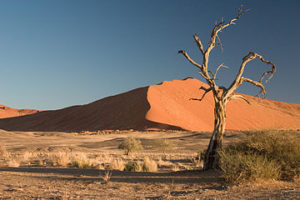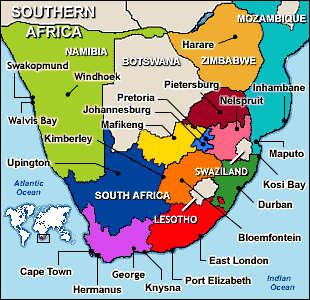SEPTEMBER 13, 2017 |

Image Wikimedia
BY GLENN SILVERMAN SEPTEMBER 12, 2017
Reflections on Namibia and its neighbours….. Namibia has a large land mass, some 66% of that of South Africa, and far larger than that of either Germany or the UK – countries with which it shares some historic linkages. Yet for all its size, is has the lowest population density of any sovereign country in the world, outside of Mongolia. Its population of 2.5 million is roughly double that of Mauritius (1.3m) – a country less than 1% of its size. And whilst Namibia borders SA, Zambia, Angola and Botswana, it is with ‘big brother’ SA that it shares much more of its history.
From 1884, Namibia was a German colony – German South West Africa. After the First World War, the League of Nations mandated South Africa to administer the territory. This set of events ensured that SA’s influence, and its own particular history, would play a significant role in that of Namibia. It also ensured that Namibia would share its part of SA’s ‘national scar’, that of Apartheid. One would have thought that that linkage would have ended in 1990, with Namibia’s independence from SA – an independence only gained after years of armed struggle by SWAPO, the then liberation party, against its far larger southern neighbour. SWAPO has dominated Namibian politics and governed the country ever since, a precedent fairly typical of Africa. Yet even post-independence SA’s influence over Namibia looms large.
Both are part of the 15-country SADC (Southern African Development Community) bloc, their exchange rates (rand and Namibian $) are linked 1:1, and 66% of all Namibian imports originate from SA. Escaping the reach and influence of its big brother has proved a challenge for Namibia in the past, and remains true to this day. Meanwhile with SA, Namibia shares some other far less virtuous macro-statistics – extremely high unemployment rates, among the highest GINI (inequality) measures globally, significant education challenges, and more. The SA economy, at some $313bn, is more than 30 times larger than that of Namibia’s approximate $10bn. That places Namibia, again, as a not too dissimilar level to that of Mauritius ($12bn). This makes for an interesting three-way comparison, when far larger SA is thrown into the mix, as captured in the table below:
Macro Statistics
South Africa Mauritius Namibia
Population (millions) 55 1.3 2.5
GDP ($bn) 313 12.2 10.3
Land Mass (km2) 1,213k 2k 825k
Number of Universities 26 6 3
Market Cap ($bn) 850 6.5 145
Market Opening (Year) 1887 1989 1992
Sources: JSE; SEM; NSX; World Bank [As at September 2016]
The dominance of SA from a size perspective, versus both the above peers, is quite clear, whether that be in terms of population size, GDP or the market capitalisation of their respective stock exchanges. The JSE is far larger than both the others for a number of reasons. One being that it opened its doors in 1887, giving it a proud 130+ year history, versus the mere 25 or 30 years of its two peers. Similarly, Namibia’s far higher market cap than Mauritius stems from a similar source: the number of SA dual-listed companies on the Namibian Stock Exchange (NSE). This provides a key challenge to the smaller countries when attempting to compete with SA for investment flows, skills and talent.
Because of its huge size advantage, one would rationally surmise that SA would similarly dominate the other two in most other key global rankings, for example the 2016 WEF Global competitiveness survey, and others of that ilk. Yet, that is not the case, with Mauritius in the ascendancy in virtually every key ranking, but with Namibia ranked even worse than SA. In every key statistic below, Mauritius scores ahead of its two peers, often significantly so. And more tellingly, this ascendancy was achieved within a decade or so. Until that time, SA had a higher ranking than that of Mauritius in many of these key areas.
Key Rankings SA Mauritius Namibia
Economic Freedom Ranking (/159) 105 5 94
Regional Ranking: Sub-Saharan Africa (/46) 6 1 5
GDP Per Capita ($) 6,600 9,200 5,700
Corruption Perceptions Index (/176) 64 50 53
WEF Competitiveness Index (/140) 49 46 85
Ease of doing Business (/190) 74 32 108
African Governance Ranking (/54) 4 1 5
Source: Fraser Institute (2016); Transparency International (2015); World Bank (2016); WEF (2016); Doing Business (2016); Ibrahim Foundation
What explains Mauritius’s far higher rankings than those of SA and Namibia? Firstly, SA’s rankings have been falling for some time, arguably since 2008 and the associated leadership changes flowing from the ANC elective conference in Polokwane. At the same time, Mauritius’ have been improving – a consequence of the more enlightened leadership, and resultant economic and fiscal policy decisions, emanating from that country. The differences in approach, and the resultant consequences, have been stark.
Mauritius embraced the free market, and opened itself up for business, arguably becoming the financial gateway for, and into, Africa – notwithstanding SA’s far larger and deeper financial markets and world-class institutions. SA has, instead, mired itself in red-tape, over-regulation, high taxation, and other forms of what is termed, ‘financial repression’. The results are clear. And where SA goes, Namibia has tended to follow.
Namibia would do well to rather exhibit real leadership by following the example of small, but more successful, Mauritius when it comes to economic and related policies. Large countries will attract investors simply due to their size, but smaller countries have to provide something appealing for investors to invest. A haven from financial repression, would be one area of competitive advantage, with lower taxes and less burdensome regulation. Those would provide a magnet for skills and talent too. Namibia should also look to use its geography, natural resources and innovative incentives to attract both capital and skills. Out-the-box thinking is required, including how best to use its huge land mass.
With the next ANC elective conference in SA taking place this December, followed by a general election in 2019, it is likely that many local and foreign investors will place SA ‘on hold’, awaiting the outcome. Good leadership choices will be rewarded, poor ones will likely be punished. This may provide SA’s neighbours with an opportunity to fill the gap. Yet SA can ill afford the delay, with the alarmingly high levels of unemployment (27%, with Namibia at 34%) and the % of the population below the poverty line (36%, with Namibia at 27%).
SA has been a proud member of the BRICS since 2010. Where SA is the ‘Big S’ in Sub Saharan Africa, it is a mere briquette when compared to the other BRIC countries on almost all measures. Yet, SA (and Namibia’s) numbers stand out strikingly versus those other emerging countries, with the BRIC countries’ unemployment levels ranging between 4% and 13%, and poverty levels between 5% and 14% – the latter excluding India, at a far higher 22%, but still well below the levels of SA and Namibia. These effectively form the new national scars of both countries, and need to be treated like the national emergency that they are.
In conclusion, the key messages that flow from the above are:
Unemployment, and its related cousin poverty, are two areas that must be given the highest priority by the governments of SA, and Namibia. All other priorities should be subservient to these, with creative measures from all sources sought to deal with both. ‘Talk is cheap’ but action is now needed. A collaborative, well-thought out, inclusive and well-communicated strategy is required. Unfortunately, that does not appear to be the case at present in either country, with more focus seemingly being placed on the past than on the future.
Size matters. As a small country, Namibia needs a strategy to positions itself relative to SA, and others in Africa. The lesson of tiny Mauritius provide some useful lessons and guidance. Competitive advantage can be created in the ease of investment and doing business, in lower taxes, in less complex and more supportive legislation, along with a supportive and consistent policy environment. Utilizing a country’s geography to best advantage, is sensible too.
Arguably, far larger SA is relatively small when contrasted with the other BRIC countries, and so it, too, would benefit from a similar approach, and line of thinking. There are big brothers – SA relative to Namibia for one, and then REALLY BIG brothers – for example, when comparing SA relative to the Asian giants of India and China.
Glenn Silverman is an asset management and BRICS consultant

